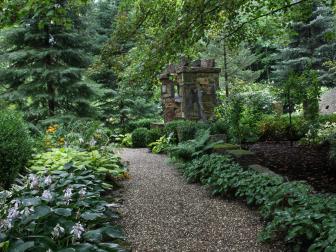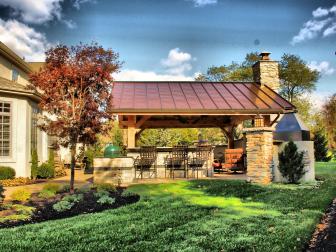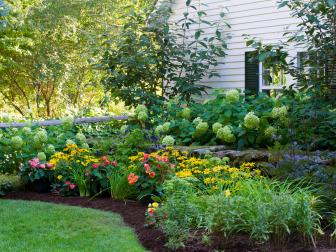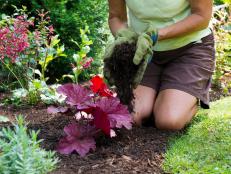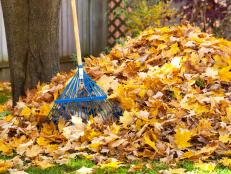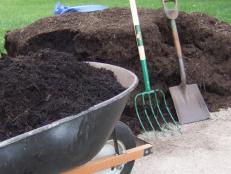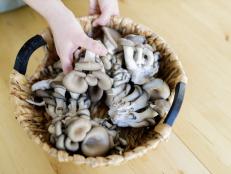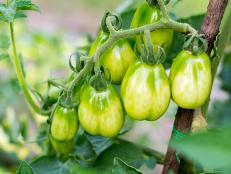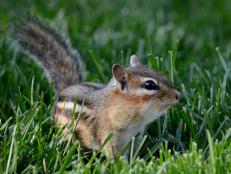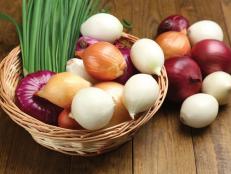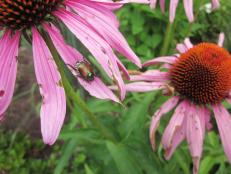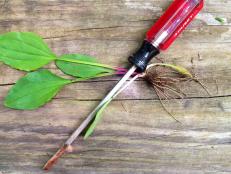What Is Mulch and Which Mulch Should You Use?
Find out from the gardening experts at HGTV about the types of mulch to use and where to use them in the garden along with other helpful tips about mulch in flower beds and vegetable gardens.

One of gardening’s secret weapons is mulch. It’s not a glamorous starlet that steals the spotlight, but its performance can make or break a landscape design.
Whether you’re grooming a fabulous front yard or raising your family’s favorite veggies in the backyard, mulch can make each planting area healthy, earth-friendly and beautiful.
Why Use Mulch
How does mulch benefit the landscape?
- It suppresses weeds and makes weeds that do sprout easier to pull.
- It slows water evaporation from soil, so you don’t have to water as often.
- It insulates soil against temperature extremes. This protects shallow-rooted plants in cold regions and coddles crops as summer sizzles.
- It prevents soil compaction during downpours. Loose, uncompacted soil yields happy, healthy plant roots.
- It slows storm water runoff and helps reduce soil erosion. Less runoff means planting beds are absorbing more rain.
- It prevents disease organisms from splashing from soil to plant leaves, which reduces disease outbreaks.
- It gives planting beds a polished look, enhancing even the most basic landscape design.
12 Clever Ways to Landscape with Stone and Mulch 12 Photos
Consider using stone and mulch to create definition and interest in your next landscaping project.
Types of Mulch
Mulch falls into two general categories: organic and inorganic.
Organic materials include things like shredded bark, pine straw, compost or grass clippings. These materials break down over time, adding organic matter to soil and improving it. Organic materials include:
- Shredded bark (hardwood or pine bark) is a popular choice. Buy by the bag at home stores or nurseries, or buy in bulk from local suppliers. Bark nuggets are larger and don’t decompose as quickly.
- Pine straw or wheat straw are easy solutions in many situations. Wheat straw – not hay, which contains seeds that will sprout in your well-tended soil – is especially good in vegetable beds. Place it over a layer of newspapers for extra weed suppression.
- Shredded leaves and grass clippings, if your landscape has trees and lawn areas, are handy, easy to use and free!
Inorganic mulches are more permanent and don’t readily degrade. Stone, weed fabric, rubber or geotextile mats are types of inorganic mulches. These are less environmentally-friendly and not as useful as organic mulches which are beneficial in a number of ways to the garden.
Mulch Products to (Mostly) Avoid
Stones, gravel or volcanic rock will not have to be replenished each year, but since they don’t break down, they don’t enrich the soil. Remember, too, that stones can hold heat, which could turn up the soil’s temperature more than the plants’ roots can stand. They may be a good choice for cactus gardens.
Rubber mulch, made from ground-up tires, is a good way to recycle old tires, but it won’t do anything to enrich the soil in your garden beds. On the other hand, it may be a good choice to use under a children’s play area.
Landscape plastic and fabric makes sense in certain conditions – under gravel paths, for example, to keep gravel from quickly working its way into the soil. But these ground covers can prevent water from reaching the roots of plants. And while they will suppress weeds, they may also be detrimental to the plants you favor.
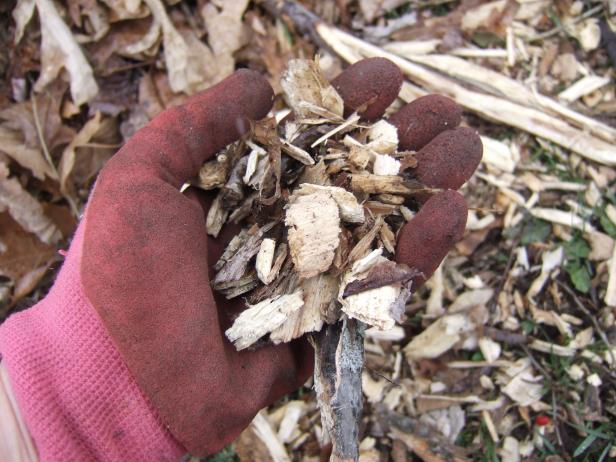
Julie Martens Forney
How to Mulch
Step 1: Thickness
Apply a 2- to 3-inch-thick mulch layer. If you’re gardening in slow-draining soil, use a thinner layer (1 to 2 inches); for fast-draining soils like sand, aim for 4 inches. A too-thick layer can lead to plant rot, diseases, pests and rodents.
10 Mulch Dos and Don’ts
Protect your plants and avoid top mulching mistakes by following these dos and don'ts.
Step 2: Placement
Extend mulch beyond the plant’s drip line — the point where the outermost edge of leaves occurs. To prevent rot, pull mulch back 2 to 4 inches from perennial crowns, shrub stems and tree trunks.
Step 3: Water
Water mulch after application. This keeps dry mulch from absorbing soil moisture (and stealing it from plant roots). Second, it helps anchor lightweight mulches easily carried by wind.
What to Mulch
Mulch keeps the soil in a garden bed cooler and moister during dry spells in summer, improves soil structure over time, and helps keep unwanted plants – those things we call often call “weeds” – from taking over your perennial, annual and vegetable beds.
But how much mulch is enough? And is it possible to use too much? As a general rule, one to three inches of mulch spread over the soil will do a good job of keeping garden beds protected and holding weeds at bay. But there are details to consider for specific plantings.
Perennials and annuals: A two-inch layer of mulch can keep perennials and flowering annuals content during the growing season. As it decomposes, you may need to add another inch or so to replenish the bed.
Roses: These beauties need plenty of water, so a thick blanket of mulch – three to four inches – will help retain moisture in the soil. Make sure the mulch is not piled up around the base of the plant.
Bulbs and tubers: It’s not necessary to mulch bulb beds at planting time. If mulch is used, the depth of the mulch should be figured in to the planting depth of the bulb. Tubers that are planted in a shallow bed, such as bearded irises, should not be covered with heavy mulch.
Vegetables: A layer of pine straw, wheat straw or grass clippings or compost between the rows in your raised or in-ground beds can discourage the unwanted weeds that compete with your produce for water and nutrients.
Mulching Trees and Shrubs
When you plant new trees or shrubs, a deep layer of mulch can help get these larger landscape features off to a good start.
What you don’t want is a “mulch volcano,” a thick mound piled high up against the trunk of the tree or shrub. This heavy, moist mountain of mulch covering the base of the tree causes the outer bark to decay and leaves the tree vulnerable to disease. It also smothers the trees roots, and over time, the roots begin to grow into the mulch where they are more exposed and vulnerable to damage and disease.
To mulch a newly-planted tree or shrub, place a two- to four-inch layer of mulch around the tree out to the tree’s drip line, then use a rake to pull the mulch away from the trunk so that you can see the root flare, the point where the tree trunk meets the roots. This creates a “saucer” around the tree that helps direct water to the tree’s roots.
When to Mulch
Apply mulch year round in every climate. In the coldest regions, to protect overwintering plants, apply mulch after the ground freezes. To insulate soil against summer heat, apply mulch in late spring after soil warms.
13 Fall Mulch Tips 13 Photos
Make the most of your fall garden mulching by following some key tips.
Organic mulches break down through the growing season — faster in warmer regions. Typically, you’ll have to re-apply organic mulch annually. Check mulch thickness occasionally; replenish as needed.
Learn how and why you should use your fall leaves for winter mulch.
Shopping for Mulch
You’ll find the best mulch bargains when you buy in bulk, but that means you’ll need a pickup truck. Bagged mulches can be easier to transport and may be the best deal for small front yard beds or modest backyard planting areas. Most stores give discounts for broken bags; ask at the register.
Good organic mulch should have an earthy, damp odor. If you smell ammonia, vinegar, alcohol or sulfur, don’t buy that mulch. It could actually harm plants.
Find the Right Mulch
The perfect mulch:
- doesn't compact
- decomposes relatively slowly
- is water- and air-permeable
- is fire-resistant
Every mulch type offers distinct advantages. How can you choose the one that’s right for your gardening situation?
Learn more about different mulches in our Landscape Mulch Gallery below.
Landscape Mulch Gallery
Which Mulch is Best for Your Yard? 15 Photos
Find out what type of mulch is best for your yard, plus, get tips on the best way to buy mulch.







